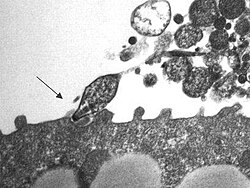Mycoplasma
Mycoplasmas are among the prokaryotic organisms. They occur naturally in animals, plants, insects, soil and humans. It was first observed in the late 19th century when it was isolated from cattle that contracted pleuropneumonia.
Morphology[edit | edit source]
Mycoplasma can have different shapes depending on the conditions for growth and the stage of their growth cycle. They are so-called pleomorphic, they can take round, coccobacillary, ring, dumbbell and fibrous forms.
The cell is bounded by a membrane, with some species having a dense shell-like layer on the outside of the membrane, while others have superficial sharp protrusions, probably important for bacterial adhesion to the eukaryotic cell. Adhesion close to the eukaryotic cell (or erythrocyte) is necessary to introduce nucleases and other enzymes into the infested cell and thus to obtain enzymatic cleavage products, e.g. nucleotides. Mycoplasmas do not have a cell wall like other bacteria, as they are not capable of peptidoglycan synthesis. Corresponding to this is the fact that they are completely resistant to antibiotics that block bacterial wall synthesis, including penicillin.
As in other bacteria, we do not find an endoplasmic reticulum in the cytoplasm of the mycoplasma. There are only ribosomes and a nuclear substance that can be dispersed or located in the center of the cell.
Colony[edit | edit source]
Mycoplasma grows, when cultured in agar, in colonies resembling poached eggs. These colonies have a translucent zone on their surface, their center is cloudy and they penetrate into the cultivation soil.
Disease[edit | edit source]
Upto this date, 11 human species of mycoplasma have been isolated, of which only three, Mycoplasma pneumoniae, Mycoplasma hominis and probably Mycoplasma genitalium, have been shown to cause the disease.
Mycoplasma pneumoniae[edit | edit source]
Mycoplasma pneumoniae is the most important pathogen of the human respiratory system. It is the main cause of a large number of respiratory infections (pharyngitis, tracheobronchitis, bronchitis, bronchiolitis, pneumoniae, pneumonitis, acute otitis, bullous hemorrhagic myringitis), which occur on all continents except Antarctica. Serological testing for antibodies serves as evidence of M. pneumoniae during infection.
Antibiotic treatment is suitable for more severe forms of infection. M. pneumoniae is sensitive to tetracyclines, erythromycin, semisynthetic macrolides and azithromycin. However, antibiotics do not kill this bacterium, they only stop it from multiplying. For antibiotic treatment to be effective, it is necessary to use them for 2-3 weeks.
Mycoplasma hominis[edit | edit source]
Mycoplasma hominis is a commonly found pathogen predominantly in the urogenital system in women and sexually active men. It causes a number of different infections that can result in pelvic inflammatory disease (PID), postpartum or post-abortion fever, or extragenital infections in immunosuppressed individuals. It can also cause meningitis, pneumonia or abscesses in newborns. In the case of treatment, the increasing resistance of M. hominis to antibiotics, including erythromycin, is significant.
Mycoplasma genitalium[edit | edit source]
Mycoplasma genitalium is a parasitic bacterium that has the shortest genome of all known wild bacteria. It most likely evolved from gram-positive bacteria.
M. genitalium is mobile. It uses a special end adhesive organelle to attach to the host cell and move along its surface. It is one of fifteen mycoplasmas found in humans and is very often associated with many urogenital infections in both men and women, although it has not yet been fully established as the main cause. The primary infected tissues include the urogenital tract, but M. genitalium has also been isolated from the respiratory tract. It damages the infected tissues with its toxins and metabolic products (H2O2, superoxide metabolites), but the host's own immune system also contributes more to the damage.
In men, M. genitalium is responsible for nongonococcal urethritis; in women, it causes cervicitis and deep pelvic inflammation. Its association with infertility and abortion has not been satisfactorily demonstrated.
Video Mycoplasma pneumoniae[edit | edit source]
<mediaplayer width='500' height='300'>https://www.youtube.com/watch?v=9_icJ0peNEk</mediaplayer>
Links[edit | edit source]
Related articles[edit | edit source]
External links[edit | edit source]
Source[edit | edit source]
- GREENWOOD, David – PEUTHERER, John F, et al. Lékařská mikrobiologie : přehled infekčních onemocnění. 1. edition. Praha : Grada, 1999. ISBN 80-7169-365-0.
- TORŠOVÁ, Věra – MEDKOVÁ, Zuzana. MYCOPLASMA PNEUMONIAE A CHLAMYDIA PNEUMONIAE: PŮVODCI RESPIRAČNÍCH INFEKCÍ A JEJICH VZTAH K NĚKTERÝM CHRONICKÝM ONEMOCNĚNÍM. Interní medicína pro praxi [online]. 2001, y. 3, vol. 1, p. 13-18, Available from <http://www.internimedicina.cz/pdfs/int/2001/01/04.pdf>. ISSN 1803-5256.



